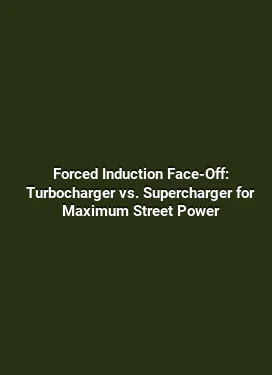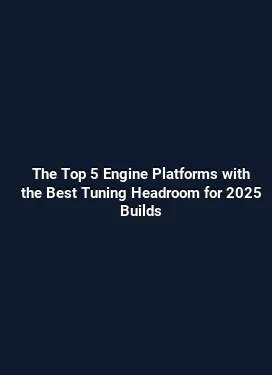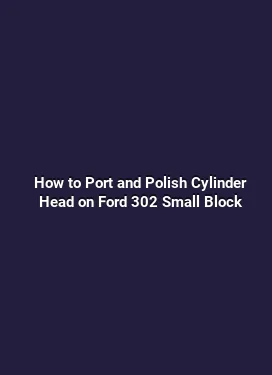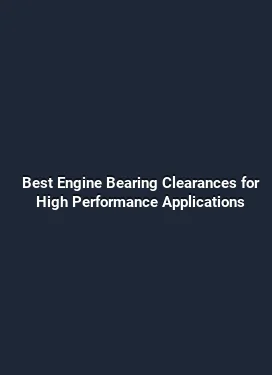Best Valve Springs for High Lift Camshafts: Single vs Dual Spring
Understanding High Lift Camshafts and the Role of Valve Springs

High lift camshafts are designed to increase valve lift and duration, enabling more air and fuel to enter the combustion chamber. This can translate into higher power output, particularly at higher rpm, but it also places greater demands on the valvetrain. Valve springs play a critical role in controlling valve motion, maintaining valve-to-piston clearance, and ensuring accurate valve timing under heavy engine loads. When selecting springs for a high lift setup, it is essential to consider spring rate, coil bind, installed height, and material properties. These factors interact with the cam profile, lifter geometry, retainer and keeper choices, and the overall engine management strategy.
In tuned engines, the goal is to balance valve control with reliability. Lightweight spring cores, optimized dampening, and careful consideration of dynamic inertia can reduce valve float at high rpm while preventing excessive spring surge. The process involves matching the spring to the camshaft lobe profile, the valve train geometry, and the desired operating range. The outcome should be a stable spring force across the RPM range, proper containment of valve motion, and predictable ignition and fuel delivery behavior under load.
Key Parameters to Consider

Several parameters define a valve spring’s suitability for high lift camshafts. The spring rate, typically measured in pounds per inch (lb/in), determines how much force is required to compress the spring. A higher rate helps control valve motion at higher lift and rpm but also increases the load on the lifters and the drive system. The installed height, or the distance from the spring seat to the top of the retainer when the valve is closed, affects the spring’s effective rate and the potential for coil bind. Retainer and damper design influence how the spring responds to rapid valve acceleration and deceleration, contributing to damping of stick-slip and valve bounce.
Coil bind, occurrence where adjacent coils contact each other, is a critical limit. If a spring reaches coil bind before top-dead-center or bottom-dead-center, it can fail to control valve motion and may lead to catastrophic valve train damage. Spring materials, heat treatment, and optional sodium or oil dampers add resilience under high-temperature operation. When selecting springs for a high lift cam, engineers evaluate how the spring behaves across the entire operating envelope, including hot-starts, restarts, and rapid throttle transitions.
Single vs Dual Valve Springs: Pros, Cons, and Performance Implications
The classic decision in high lift applications is whether to employ a single spring or a dual (paired) spring configuration. Each approach has distinct advantages and trade-offs that influence reliability, rpm capability, and drivability. A single spring is typically lighter and simpler, reducing valve train mass and potential friction losses. For some applications, a properly tuned single spring can deliver adequate control across a broad rpm range, especially when paired with a cam profile that avoids aggressive acceleration. However, as lift increases and rpm climbs, the risk of valve float and pump gas recirculation rises, making a dual-spring setup appealing for additional stiffness and damping.
Dual springs increase the total spring force and often improve damping characteristics. The inner and outer springs can be sized to provide progressive control: the outer spring handles base-level valve motion, while the inner spring engages at higher lift and rpm. This configuration can significantly reduce valve float and reduce the likelihood of coil bind by distributing the load. On the downside, dual springs add mass to the valvetrain, require more precise seat height and finish, and demand careful balance with the damper and retainer. The additional components also introduce a potential source of valve train harmonics if not properly tuned.
Spring Rate, Coil Bind, and RPM Range
In practice, selecting the right rate requires simulating or testing the system across the engine’s RPM band. A higher-rate outer spring can improve stability at the top end but may rob low-end response or increase friction. The inner spring, when present, should engage around peak lift to assist in maintaining valve control without overpowering the cam’s lobe profile. Monitoring coil bind is essential; a miscalculation can lead to interference with the piston, valve-to-piston contact, or damaged seats. When tuning, engineers often perform light to moderate pressure testing with the engine at elevated temperatures to observe valve spring surge and potential rebound characteristics.
RPM range targets drive the choice between single and dual springs. Naturally aspirated engines with aggressive camshafts, or forced induction setups with extended lift, tend to benefit from dual-spring configurations to sustain control beyond mid-range speeds. Boosted or nitrous-assisted builds require particular attention to spring harmonics, as higher lift interacts with cylinder pressure changes that affect valve motion. The practical approach combines data-driven testing with careful observation of valve events during high-load experimentation.
Material Choices and Modern Technologies
Materials have evolved beyond traditional steel to address wear resistance, heat dissipation, and weight reduction. Stainless steels and chrome-silicon alloys remain common, while some manufacturers explore high-strength alloys and coated springs to minimize galling and friction. In high lift applications, damping elements, such as polymer or integrated dampers, can be added to the spring assembly to mitigate valve train oscillations caused by rapid accelerations. Lightweight spring cores help reduce rotating mass, contributing to quicker valve response and smoother engine breathing at high RPMs.
Heat management is a critical consideration. High lift cams operate in an environment where exhaust heat and frictional losses raise the valve stem temperature. Some designs incorporate enhanced heat treatment or surface coatings to improve wear resistance and longevity. The interaction of spring material with the valve stem, retainer, and keeper is particularly important, as any mismatch can lead to fatigue or fatigue cracks over time. When selecting components, matching the coefficient of thermal expansion and ensuring compatible seat geometry helps maintain consistent performance under varied operating conditions.
Hardness, Damping, and Heat Management
Hardness influences spring durability and resistance to plastic deformation under extreme loads. Damping, provided by the damper or internal spring geometry, helps suppress undesirable valve train oscillations that can occur at high rpm with aggressive cam profiles. Heat management strategies, including adequate cooling, oiling, and, in some cases, external dampers, help maintain spring life and stability. For enthusiasts chasing peak horsepower, the goal is to maintain stable valve motion throughout the RPM envelope without sacrificing reliability or driveability.
Tuning Considerations: Installation, Geometry, and Diagnostics
Installation precision is paramount. Achieving the correct installed height ensures that the spring remains within its optimal operating window as the valve moves. Incorrect height can alter the effective rate, increasing the risk of coil bind or valve float. Proper seating and alignment of the retainer, keepers, and damper accessories reduce the chance of misalignment, which can cause noise, wear, or catastrophic failure. When upgrading to high lift camshafts, a comprehensive valvetrain inspection is essential to verify the compatibility of all components, including pushrods, rocker arms, and lifters.
Diagnostics are invaluable for confirming that the chosen spring configuration delivers the intended performance. Methods include cold and hot compression checks, float tests at various rpm, and non-destructive testing to identify wear patterns. Modern engines benefit from data logging that captures valve timing events, piston speed, and engine breathing efficiency. Combined with a careful baseline comparison, this data enables fine-tuning of spring rates, dampening, and installed heights to optimize performance while preserving reliability under real-world driving conditions.
Practical Testing Methods
Practical testing involves staged testing across different loads and rpm bands. With a single-spring setup, focus on stability near redline and at high manifold pressures. For dual springs, verify smooth engagement of the inner spring at peak lift and assess whether there is any ring or coil contact under high acceleration. A controlled dyno test with a well-calibrated ignition and fuel map helps isolate the valve train’s contribution to performance. Regular inspection of the valve springs, retainers, and seats after high-load sessions minimizes the risk of overlooked defects that could escalate into failures later on.
Maintenance, Longevity, and Practical Upgrades
Maintenance practices influence cold-start behavior, idle stability, and long-term reliability. Valve spring life is affected by continuous high-load cycling, heat load, and oil cleanliness. Regular oil changes with the correct viscosity and additive package help manage piston ring and valve stem temperatures, reducing the risk of accelerated wear. Upgrading to corrosion-resistant fasteners and ensuring the correct torque sequence during assembly enhances the valvetrain’s durability. When building or modifying a high lift setup, consider documenting every change—from cam profile and spring rate to installed height and damper configuration—to build a reproducible tuning log that can inform future iterations.
In many builds, the choice between single and dual springs also intersects with other performance goals, such as peak torque delivery, throttle response, and fuel efficiency. A thoughtful approach to the valvetrain, including careful selection of springs, dampers, and geometry, yields a robust combination that suits rally, track, or daily-driver ambitions. The end result is a smooth, powerful engine where valve control remains confident across the operating range, enabling consistent power delivery and predictable ignition timing during spirited driving.
Case Studies: Practical Scenarios and Takeaways
Consider a naturally aspirated engine running a high lift cam with moderate duration. A well-chosen single-spring setup may offer excellent mid-range torque, light valvetrain mass, and straightforward maintenance. For a turbocharged or supercharged build where the camshaft imposes significant inertial forces at high rpm, a dual-spring configuration can provide the additional damping and stiffness needed to prevent valve float and to maintain precise timing. In both cases, precise installation, verified geometry, and systematic testing are essential to avoid common pitfalls such as coil bind, retainer-to-guide interference, or lifter wear.
Finally, remember that engine management and tuning are intertwined with the valvetrain’s behavior. While the focus here is on springs and related hardware, successful outcomes rely on harmonizing air intake, exhaust back-pressure, ignition timing, and fueling strategy with the physical limits of the valve train. A data-driven approach, combined with hands-on testing and careful inspection, yields a reliable and high-performing setup that remains resilient under diverse driving conditions.






